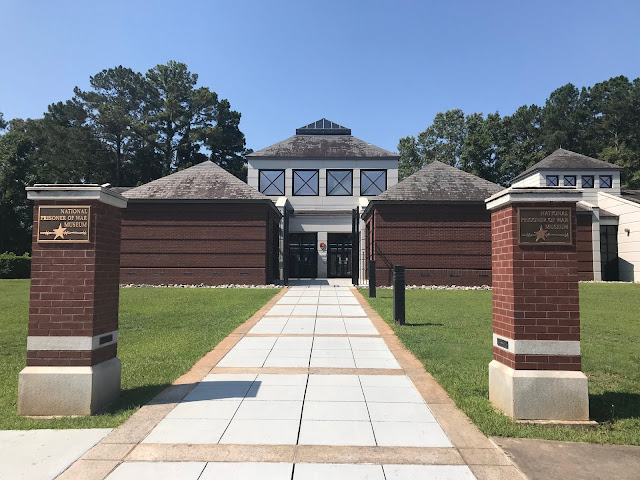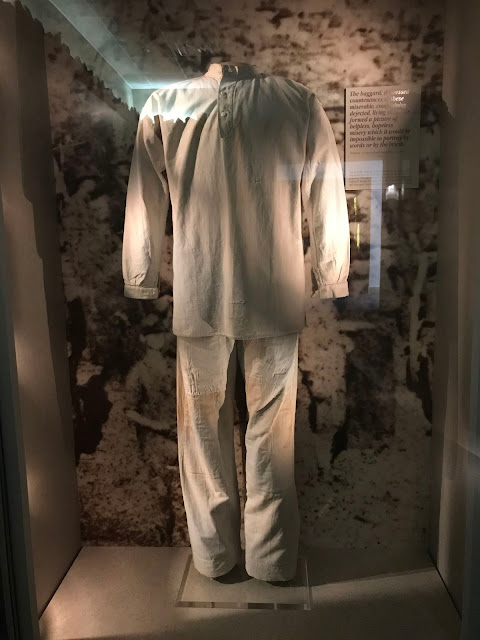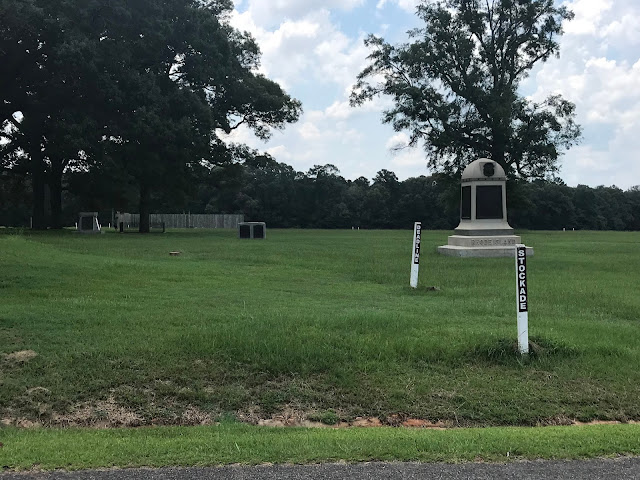First, we'll stop at the Visitor Center. There was a whiteboard listing what happened June 19th, 1864 - 154 years ago the day I was there...
After I did research at the database, I walked through a memorial garden before walking to the remaining prison walls..
Here at the remaining walls, you can see part of the fence that was put up there around the prison, the "deadline," which is a 13 foot area inside the prison where prisons were NOT permitted to cross - even a hand or finger. Many men were shot and killed just for having an arm or foot across the line. At one point in the above book, women from Andersonville came to "see" the prisons, smelled the stench from inside, and one woman crossed into the deadline and a prison told her to get back - in turn a leaned through the deadline to save her and the guards shot him dead! Each soldier to came to Andersonville kept the clothes on his back, money in his pocket, and anything he had unless is was taken from him. At the prisons, the prisoners had to supply their own bedding, tent for shelter and food. They were given one piece of cracker per day sometimes more and sometimes nothing at all. Many starved to death, others from the elements, other from lack of water - except for the spring that held animal feces and urine that they had to drink, others from scurvy. It was, as was described in the book, "hell" and the men thought this must be hell. Inside Andersonville prison, some Union soldiers were ruffians and harassed and killed other soldiers for money, food, shelter, etc. Finally, men in the prison got together and hung the six men who did these things and law and order was established. Now, I've mentioned all the horrible BUGS and the heat this morning was in the 90s by 10 a.m. with 60-80% humidity. Can you imagine this place in August?! I just can't. It was miserable just to walk around part of the prison and I was drenched from sweat from the heat in only an hour. I was dying for water. Can you imagine being a prisoner there and having nothing to eat or drink?! What a ghastly place is must have been for sure and the stench must have been horrible - not just body sweat but excretions as well.
 |
| The wood fence is the "deadline." |
At the Andersonville National Historic Site is also the National POW Museum including information on the Vietnam War that I found interesting and sobering.
Also, on the drive, I discovered other sites - the stockyard, more on the size of the prison as it expanded and notice the venomous snakes that lived near the watering hole. So, not only were you starving, lack of water and hygiene but also dealing with creapy venomous snakes!
 |
| This was the original steam the men had to drink from - filled with feces and urine. |
 |
| Men walked through these doors to enter Andersonville Prison. |
 |
| The Stockade looking down to Providence Spring. |
 |
| The Stockade and Providence Spring |
 |
| This stone is the end of the prison. It went down the valley and up to the other side by the statues and to the right where the road curves. This held 26,000 men! |
 |
| Lucius Wainwright Cemetery Stone. Section E. I placed a penny on his grave. Artificial flowers are not allowed and I didn't have any fresh flowers. |
 |
| Lucius stone is at the bottom right corner |
If you ever get the chances to come to Andersonville, I would highly recommend it. There is just so much information to learn and the opportunity to pay homage to those who paid the ultimate price for freedom from oppression.






























































































Sue, I don’t even have words after reading all of this. It amazes me that there still so many people who think the south was right and should have won the war. I cannot believe the horrible conditions and the thousands of soldiers who died at Andersonville. I had heard of this prison but didn’t know much about it. It sounds like Clara Barton truly was an angel. Thanks for sharing so much information. This is a place I think I need to go to as well.
ReplyDeleteWell, it wasn't true the North was all good. North prison camps weren't the best either, but much, much better than this. One of the problems was that Ulysses S. Grant refused to do prisoner exchanges thinking that the southern soldiers would come back and fight and the war would never end. So, he made the northern prisoners stay where they were. He has the death of all these men on his shoulders along with Capt. Wirz who was the prison commandant. It was a no-win situation. It was just a sad time in our history, for sure.
Delete